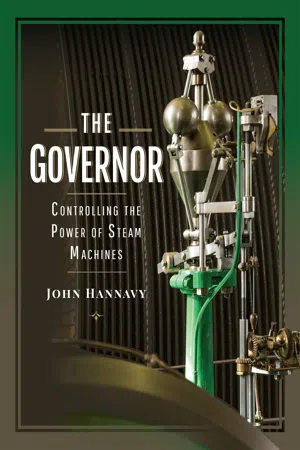
The Governor: Controlling the Power of Steam Machines
John Hannavy
- 160 pagine
- English
- ePUB (disponibile sull'app)
- Disponibile su iOS e Android
The Governor: Controlling the Power of Steam Machines
John Hannavy
Informazioni sul libro
Power without control is unusable power, and long after the invention of the steam engine, finding ways of applying that power to tasks where consistency was of paramount importance was the 'Holy Grail' which many steam engineers sought to find. It was the centrifugal governor which brought precision to the application of steam power, and its story can be traced back to 17th century Holland and Christiaan Huygens' development of both the pendulum clock and system controls for windmills, and governors are still at the heart of sophisticated machinery today – albeit electronic rather than mechanical. Without the centrifugal governor, precise control over the increasingly-complex machinery which has been developed over the past two centuries would not have been possible. It was the first device to give the engineman the control they needed. As machine speed increased, the governor had to evolve to keep pace with the demands for greater precision. Over a hundred British patents were applied for in the nineteenth century alone for ‘improvements’ in governor design, many of which could be fitted, or retro-fitted, to engines from every large manufacturer. Some enginemen, on taking up new appointments – their jobs depending on the precision and consistency of their engine’s operation – would even request that the governor be replaced with their preferred model. This book, the first to deal with the subject, tells the story of the evolution of the original ‘spinning-ball’ governor from its first appearance to the point where it became a small device entirely enclosed in a housing to keep it clean, and thus hidden from view.
Domande frequenti
Informazioni

PLACES TO SEE GOVERNORS AT WORK
www.abbeypumpingstation.org | tel: 116 299 5111 |
www.enginemuseum.org | tel: 01625 874426 |
www.bancroftmill.org.uk | tel: 01695 424166 |

www.beamish.org.uk | tel: 0191 370 4000 |
www.museum.wales/bigpit/ | tel: 0300 111 2333 |
www.birminghammuseums.org.uk/thinktank | tel: 0121 348 8000 |
www.ironbridge.org.uk/explore/blists-hill | tel: 01952 433424 |
Indice dei contenuti
- COVER
- TITLE
- COPYRIGHT
- CONTENTS
- ACKNOWLEDGEMENTS
- INTRODUCTION
- HUYGENS’ PENDULUM
- JAMES WATT – HARNESSING STEAM
- THE QUEST FOR PRECISION
- SELECTED PATENTS (1698–1913)
- BRITISH GOVERNOR MAKERS AND SUPPLIERS
- PLACES TO SEE GOVERNORS AT WORK
- SELECTED BIBLIOGRAPHY